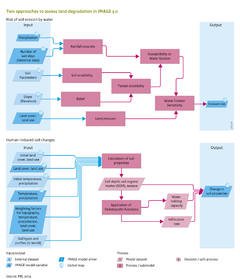Land degradation/Description: Difference between revisions
Jump to navigation
Jump to search
No edit summary |
No edit summary |
||
| Line 1: | Line 1: | ||
{{ComponentDescriptionTemplate | {{ComponentDescriptionTemplate | ||
|Reference=Oldeman et al., 1991; Batjes, 1997; Harris et al., 2013; | |Reference=Oldeman et al., 1991; Batjes, 1997; Harris et al., 2013; | ||
|Description=Water erosion is the main cause of land degradation (1049 million hectares (Mha), followed by wind erosion (548 Mha), chemical degradation (239 Mha) and physical degradation (83 Mha) (GLASOD; [[Oldeman et al., 1991|Oldeman et al. (1991)]]). IMAGE assesses soil erosion by water ([[Hootsmans et al., 2001]]) by calculating a water erosion sensitivity index, ranging from zero (no erosion risk) to one (extremely high erosion risk). This risk is calculated for each grid cell as the compounded result from the following indices: | |Description=Water erosion is the main cause of land degradation (1049 million hectares (Mha), followed by wind erosion (548 Mha), chemical degradation (239 Mha) and physical degradation (83 Mha) (GLASOD; [[Oldeman et al., 1991|Oldeman et al. (1991)]]). IMAGE assesses soil erosion by water ([[Hootsmans et al., 2001]]) by calculating a water erosion sensitivity index, ranging from zero (no erosion risk) to one (extremely high erosion risk). This risk is calculated for each grid cell as the compounded result from the following indices: | ||
* terrain erodibility index: terrain erodibility represents the water erosion characteristics of the terrain in an index that combines surface relief and soil properties, expressed as index numbers. The relief index is a landform characteristic derived from a digital elevation model, calculated from the difference between minimum and maximum altitude in a 10 minute grid cell. The index is 1 for a difference of 300 m or more and zero for no altitude differences, with a linear relationship assumed between the two extremes. The soil erodibility index is derived from indices on soil texture, bulk density and soil depth. Soil characteristics were deduced from the 0.5x0.5 degree resolution in the [[WISE database]] ([[Batjes, 1997]]). | * ''terrain erodibility index'': terrain erodibility represents the water erosion characteristics of the terrain in an index that combines surface relief and soil properties, expressed as index numbers. The relief index is a landform characteristic derived from a digital elevation model, calculated from the difference between minimum and maximum altitude in a 10 minute grid cell. The index is 1 for a difference of 300 m or more and zero for no altitude differences, with a linear relationship assumed between the two extremes. The soil erodibility index is derived from indices on soil texture, bulk density and soil depth. Soil characteristics were deduced from the 0.5x0.5 degree resolution in the [[WISE database]] ([[Batjes, 1997]]). | ||
* rainfall erosivity index: this index represents exposure to heavy rainfall, derived from the month of the year with the highest precipitation and number of wet (rainy) days in each month. Rainfall erosivity is largely determined by the intensity of rainfall events, because soil loss only occurs during periods of intense rainfall. Monthly rainfall intensities of between 0 and 2 mm per day are assigned an index value of zero, and days exceeding 20 mm receive a value of one, with a linear relationship assumed between these two end points. Climate data are used for the historical period ([[Harris et al., 2013]]). For future years, predictions are based on changes in precipitation according to scenarios generated by the climate model, see Component [[Atmospheric composition and climate]]. The number of wet days per month is assumed to be constant over time. | * ''rainfall erosivity index'': this index represents exposure to heavy rainfall, derived from the month of the year with the highest precipitation and number of wet (rainy) days in each month. Rainfall erosivity is largely determined by the intensity of rainfall events, because soil loss only occurs during periods of intense rainfall. Monthly rainfall intensities of between 0 and 2 mm per day are assigned an index value of zero, and days exceeding 20 mm receive a value of one, with a linear relationship assumed between these two end points. Climate data are used for the historical period ([[Harris et al., 2013]]). For future years, predictions are based on changes in precipitation according to scenarios generated by the climate model, see Component [[Atmospheric composition and climate]]. The number of wet days per month is assumed to be constant over time. | ||
* land-use/land-cover index: this index presents the level of protection against water erosion offered by various types of natural vegetation and crops. The basis for this index is the geographic distribution of land-cover types generated by the land-cover model. Most types of natural vegetation provide a high degree of protection against water erosion, while agriculture, and arable agriculture in particular, increases the vulnerability of the soil surface. A composite value is used for grid cells that contain agriculture, based on the distribution of agricultural crops in that world region | * ''land-use/land-cover index'': this index presents the level of protection against water erosion offered by various types of natural vegetation and crops. The basis for this index is the geographic distribution of land-cover types generated by the land-cover model. Most types of natural vegetation provide a high degree of protection against water erosion, while agriculture, and arable agriculture in particular, increases the vulnerability of the soil surface. A composite value is used for grid cells that contain agriculture, based on the distribution of agricultural crops in that world region. | ||
All intermediate and resulting factors are expressed as dimensionless indices from zero to one, and so too is the end indicator, Water Erosion Sensitivity Index. | |||
}} | }} | ||
Revision as of 12:14, 18 May 2014
Parts of Land degradation/Description
| Component is implemented in: |
|
| Related IMAGE components |
| Projects/Applications |
| Models/Databases |
| Key publications |
| References |
